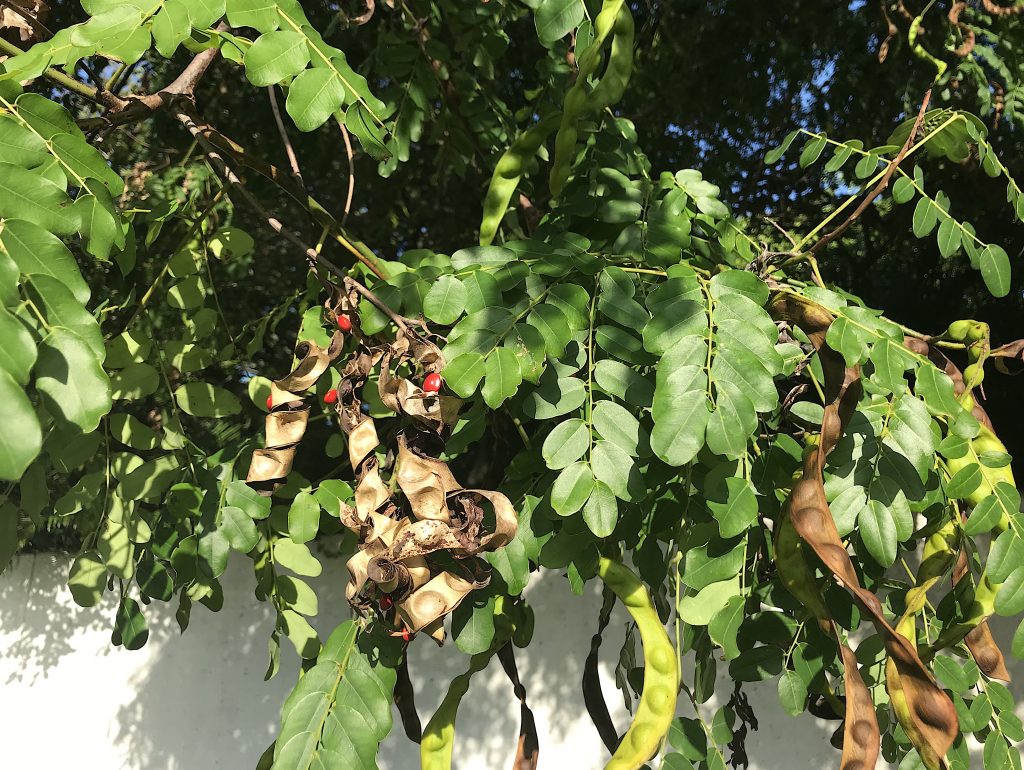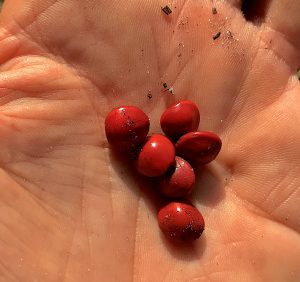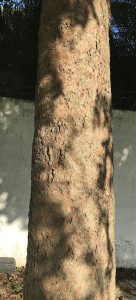
It’s easy to see the Coralwood is in the pea family. Photo by Green Deane
Coralwood seeds and leaves are edible cooked. The tree has been used for centuries as food and medicine so why is it controversial? There are two possible answers: Lack of definitions and the habit of the Internet to cut and paste.

Coralwood seeds are usually weigh a quarter of a gram each. Photo by Green Deane
Adenathera pavonina (ah-den-ah-THER-rha pah-vo-KNEE-ah) is an Old World tropic tree. In the New World it has been introduced from Venezuela to southern Florida. The species is a nitrogen fixer, is cultivated for animal forage, is a garden ornamental, has a huge array medicinal uses and dozens of common names. It is safe to say it’s been the subject or many research papers from food to medicine. The issue is raw seed edibility.
Cornucopia II, a standard published reference, says on page 152 “Seeds are eaten raw, or roasted and shelled and eaten with rice, tasting like soy beans. The husked kernels contain 25% of their weight of oil with a protein content of 39%. Young leaves are cooked and used as a vegetable.” That’s from the 1998 edition of Cornucopia II.
The Internet, revealing cutting and pasting from Wikipedia, references an 1889 Australian book that they say says the uncooked seeds are toxic. I happen to have a copy of that book: “The Useful Native Plants of Australia.” It does not say the seeds are toxic. This is exactly what the author, J.H. Maiden, wrote on page 5:
“In India these seeds are occasionally used as an article of food. They are the size of a kidney bean. They would doubtless require boiling, or some similar preparation, for it should be borne in mind that the Leguminosae must be regarded as a poisonous Natural Order in spite of the fact that it yields some of the most valuable foods used by man and beast.”
Heck, in my classes I tell students the pea family is not a friendly one. A lot of species in the pea family are toxic from weeds to trees. What Maiden wrote is far from saying Coralwood has toxic seeds. He wrote a warning in general about the legume family (which also holds true for uncooked kidney beans et cetera.)

Coralwood is used for firewood, lumber and building houses. Photo by Green Deane
At any rate are doubts: In all the professional studies I read the seeds were cooked. They were made into everything from a nut milk to ground chicken feed. Most of the internet authors who say the raw seeds are edible also say the seeds often have to be cooked to reduce “toxicity.” That “toxicity” is usually unstated. Perhaps getting closer to the truth a government website in Singapore says “Uncooked seeds (though toxic) have been used as [an] intoxicant.” Not reported are the effects of the intoxication. To be on the safe side we should cook the seeds which includes roasting and boiling (which in itself is confusing. Roasting usually degrades a bad chemical, such as calcium oxalate. Boiling often carries a toxin away as when we boil poke weed.) More digging reveals a possible answer: One study says the seeds “are believed to be toxic when eaten raw.” They think the “toxin” might be a trypsin inhibitor which reduces the breakdown of digested protein thus prevents the body’s utilization of the proteins. Cooking would reduce the trypsin inhibitor.
Research in the Czech Republic (reported in Emirates Journal of Food and Agriculture. 2020. 32(2): 100-108) reports: “The analyses showed that the lignoceric [acid] (17.59% and 18.24%), linoleic {acid an Omega 6 oil found in soybean and canola et cetera] (39.80% and 37.88%), and oleic acids [such as found in olive oil] (14.67% and 14.75%) were the most abundant in the oil of raw and roasted seeds, with the unsaturated forms present in higher amounts than saturated. The seeds were found to be rich of vitamin E (33.09 and 15.94 mg/100 g), whereas the contents of vitamins B1, B2, B3, and B6 were rather low. Calcium, magnesium, phosphorus, potassium, and sulphur were the minerals found in the highest concentrations. Salicylic acid (201.01 and 151.95 µg/100 g) has been detected in higher amounts than other phenolic compounds. In summary, the findings of this study indicate that the both raw and roasted seeds of A. pavonina are good sources of various health-beneficial nutrients, including those reducing the negative effects of obesity. The seeds also contain many phenolic compounds and vitamin E was in four forms: Alpha, Beta, Delta and Gamma.
Adenanthera is a genus with about 13 species found in India and China. Coralwood is endemic to Southern China and India. It has been widely introduced and naturalized in Malaysia, Western and Eastern Africa as well as most islands of Pacific. It is listed as one of the worst invasive species in Jamaica and it has been classified as an invasive plant in Cuba, Puerto Rico, and many islands in the Pacific including American Samoa, Hawaii, French Polynesia, Micronesia and Australia.
In the medicinal realm the species has anti-diabetic activity, hypo-lipidemic activity, anti-hypertensive activity, anti-diarrheal activity, anti-cancer activity, antioxidant activity, antiviral activity, anti-inflammatory activity and antimicrobial properties. In India a decoction of young leaves is used for rheumatism and gout. It is also used for inflammations, blood disorders, arthritis, cholera, paralysis, epilepsy, convulsion, spasm and indigestion. Pulverized wood is mixed with water and taken orally for migraines and headaches. Bark and leaf decoction are used to treat dysentery, diarrhea and tonsillitis. Decoction of the seeds were used in pulmonary infection and externally applied in chronic opthalmia.
As it is fast growing after the first year it is used for shade trees and firewood as well as lumber for furniture, cabinets, decorative wood products and house construction. The leaves are used for fodder — high in protein, low in minerals — and breakdown easily for green manure.
Adenanthera is from the Greek ‘aden’ (sticky gland) and ‘anthera’ (anthers.) It refers to the flower anthers being tipped with sticky glands. Pavonina comes from the Dead Latin word ‘pavo’ meaning peacock-blue. While no reference is given explaining the name the leaves are dull green on top, blue-green underneath. Other scientific names for Coralwood are Adenanthera gersenii Scheff, Adenanthera polita Miq, and Corallaria parvifolia Rumph.
GREEN DEANE’S ITEMIZED PLANT PROFILE
IDENTIFICATION: A medium- to large deciduous tree, A. pavonina ranges in height to 45 feet. The tree is generally erect, having dark brown to grayish bark, and a spreading crown. Leaves are bipinnate with 2-6 opposite pairs of pinnae, each having 8-21 leaflets on short stalks. The alternate leaflets are oval-oblong with an asymmetric base and a blunt tip, being a dull green color on top and a blue-green beneath. The leaves yellow with age.
Flowers are narrow spike-like racemes, to five inches long at branch ends. They are small, creamy-yellow in color, fragrant. Each flower is star-shaped with five petals and 10 prominent stamens bearing anthers tipped with minute glands.
The curved pods are long and narrow to eight inches long with slight constrictions between seeds, dark brown in color turning black upon ripening. The leathery pods curve and twist to reveal the 8-25 showy seeds. The hard-coated seeds, are lens-shaped, vivid scarlet, and stick to the pods. The ripened pods can remain on the tree into the next season. There are some 1600 seeds per pound.
TIME OF YEAR: Early fall locally, seeds can persist into spring. In it’s native range it peaks in May.
ENVIRONMENT: It likes lowland tropics. Can be found as far north as West Palm Beach in Florida. Can tolerate a variety of soil. Growth is slow at first then very fast.
METHOD OF PREPARATION: Cooked seeds (usually roasted or boiled) and are eaten out of hand or used like soybeans. The red coating on the seed is not eaten. Boiled leaves are considered a famine food. A nut milk made from the seeds is more nutritious than nut milk made from soybeans. The seeds are roasted in a manner similar to peanuts.

